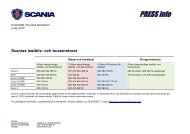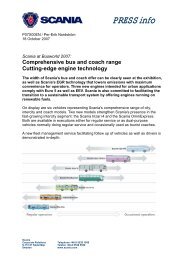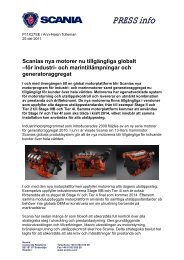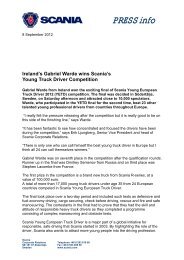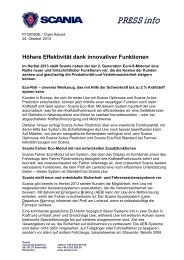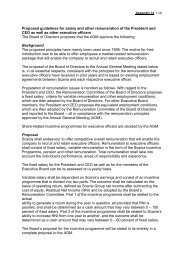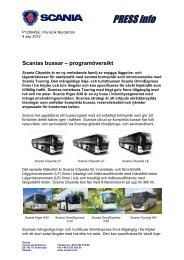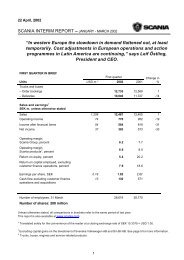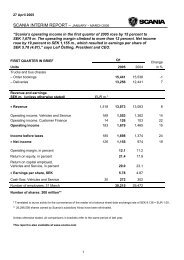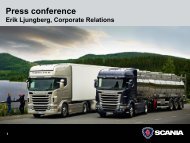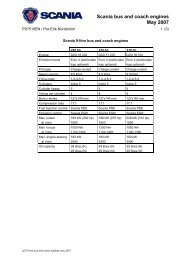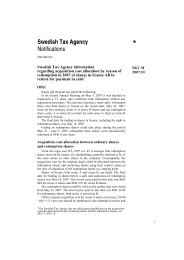Scania Annual Report 2011
Scania Annual Report 2011
Scania Annual Report 2011
You also want an ePaper? Increase the reach of your titles
YUMPU automatically turns print PDFs into web optimized ePapers that Google loves.
Risks and risk management<br />
59<br />
Risks and risk management at <strong>Scania</strong><br />
Risks are a natural element of business operations and entrepreneurship. Part of the day-to-day<br />
work of <strong>Scania</strong> is to manage risks, to prevent risks from harming the company and to limit the<br />
damage that may arise.<br />
<strong>Scania</strong> is one of the leading companies in the heavy vehicle<br />
industry. This leads to high expectations from all stakeholders,<br />
especially customers, about <strong>Scania</strong> as a company and<br />
its products and services. It is important to monitor and<br />
minimise events and behaviour that might adversely affect<br />
the company’s brand and reputation.<br />
<strong>Scania</strong>’s strong corporate culture is based on established<br />
values, principles and methods and is the foundation<br />
of the company’s risk management work. <strong>Scania</strong>’s Board<br />
of Directors is responsible to the shareholders for the<br />
company’s risk management. The company continuously<br />
reports on risk-related matters to the Board and the Audit<br />
Committee of the Board.<br />
STRATEGIC RISKS<br />
Corporate governance- and policy-related risks<br />
The Executive Board carries the main responsibility for<br />
managing corporate governance- and policy-related risks.<br />
All units of the company work according to a management<br />
system that meets <strong>Scania</strong>’s requirements, guidelines and<br />
policies and is well documented. Rapid dissemination of<br />
appropriate information is safeguarded via the company’s<br />
management structures and processes. Management systems<br />
are continuously being improved, among other things<br />
by means of regular reviews, performed both internally and<br />
by third parties. For a more detailed description of <strong>Scania</strong>’s<br />
management structure, see the section entitled “The management<br />
of the company” in the Corporate Governance<br />
<strong>Report</strong> on page 67.<br />
Business development risks<br />
Risks associated with business development and long-term<br />
planning are managed primarily through <strong>Scania</strong>’s crossfunctional<br />
(interdepartmental) meeting structure for decision<br />
making of a strategic and tactical nature, as well as<br />
<strong>Scania</strong>’s established yearly process for strategic planning.<br />
Such planning is discussed and questioned throughout the<br />
company, based on external and internal deliberations. All<br />
units and levels of the company are involved in the strategic<br />
process.<br />
Both the cross-functional meeting structure and the<br />
strategic process are long-established and are evolving<br />
continuously. Risks of overlooking threats and opportunities,<br />
of sub-optimising operations in the company and of<br />
making the wrong decisions are thereby minimised, while<br />
the risk of uncertainty and lack of clarity concerning the<br />
company’s strategy and business development is<br />
managed in a systematic way.<br />
Research and development projects are revised<br />
continuously on the basis of each project’s technological<br />
and commercial relevance.<br />
OPERATIONAL RISKS<br />
Market risks<br />
The demand for heavy trucks, buses and engines is<br />
affected by economic cycles and is thus subject to fluctuations.<br />
With regard to truck sales, in historical terms it<br />
is also possible to discern a cyclical pattern. In addition,<br />
truck sales undergo more temporary variations around<br />
their long-term growth trend.<br />
Countries and regions may suffer economic or political<br />
problems that adversely affect the demand for heavy<br />
vehicles. Fluctuations in world financial markets have a<br />
large or small impact on real economic cycles and thus<br />
on the demand for <strong>Scania</strong>’s products. Markets may temporarily<br />
stall, and local currencies may depreciate.<br />
A well-diversified market structure limits the effect of<br />
a downturn in any given market. In individual markets,<br />
substantial changes may occur in the business environment,<br />
such as the introduction or raising of customs<br />
duties and taxes, introduction or cessation of stimulus<br />
measures as well as changed requirements for vehicle<br />
specifications. Impositions of sanctions against certain<br />
countries may reduce the potential for marketing<br />
<strong>Scania</strong>’s products. In addition, shortcomings in national<br />
legal systems may substantially impair <strong>Scania</strong>’s ability to<br />
carry out operations and sales.<br />
<strong>Scania</strong> monitors all its markets continuously in order<br />
to spot warning signals early and be able to take action<br />
and implement changes in its marketing strategy.<br />
Risks in the sales and services network<br />
Repair and maintenance contracts comprise one<br />
important element of sales and services business and<br />
help to generate good capacity utilisation at workshops<br />
and greater customer loyalty. These contracts are often<br />
connected to predetermined prices. Thus both price<br />
and handling risks arise.<br />
One advanced form of business obligation is an uptime<br />
guarantee for a vehicle, in which the customer pays<br />
for the distance or time it is used. <strong>Scania</strong> works actively<br />
to improve the expertise and ability of its sales and<br />
<strong>Report</strong> of the directors <strong>Scania</strong> <strong>2011</strong>



